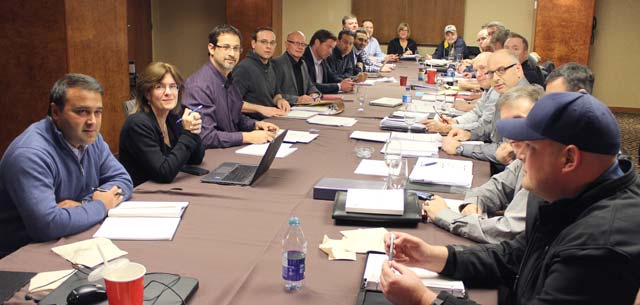Toronto, ON – The table in the Interlaken Room at the Airport Sheraton was covered in paper, empty coffee cups, pop bottles, water bottles, candy wrappers, scribbled notes, proposals and counter-proposals.
There was a sense of finality that was hanging in the air, a deal, a rather lengthy deal that was only moments away from completion. There was tentative labour peace at Air Canada with the members of the IAM) The deal was also on that table and one by one the documents – amendments, letters of understanding, commitments, wage schedules, contract language changes – all the contents of a new collective agreement were being signed.
“It marks the first time in over a decade we have been able to bargain freely without the threat of bankruptcy or government interference hanging over us,” explained IAM Transportation District 140 President and Directing General Chairperson Fred Hospes. “This is proof that the collective bargaining process can work if the parties involved are left alone to work things out.”
 Bargaining teams for Air Canada (left) and IAM Transportation District 140 gather for the final time to finalize and sign a tentative agreement covering the next ten years. Negotiations began in September 2015 reaching a tentative agreement in Vancouver just before Christmas. The meeting January 7, 2016 in Toronto finalized outstanding issues so the agreement could be put before the 8,200 members at ratification meetings across the country.
Bargaining teams for Air Canada (left) and IAM Transportation District 140 gather for the final time to finalize and sign a tentative agreement covering the next ten years. Negotiations began in September 2015 reaching a tentative agreement in Vancouver just before Christmas. The meeting January 7, 2016 in Toronto finalized outstanding issues so the agreement could be put before the 8,200 members at ratification meetings across the country.
“This provides job security for our airports people,” explained Hospes. For the duration of this agreement our members will continue to perform the regional ground handling work in their locations. So no matter what the station, no matter who the operating carrier is, our members’ jobs are safe. We didn’t have this language before.”
 Bargaining Team Chairperson and IAM Transportation District 140 General Chairperson Ken Russell hands over just one of many signed documents to his counterparts from Air Canada. Russell is flanked by his co-chairs, Keith Aiken (left) and Lou Pagrach (right)
Bargaining Team Chairperson and IAM Transportation District 140 General Chairperson Ken Russell hands over just one of many signed documents to his counterparts from Air Canada. Russell is flanked by his co-chairs, Keith Aiken (left) and Lou Pagrach (right)
The tentative agreement covers more than 40 job classifications in Technical Operations, Airports and Cargo and Logistics and supply. “We have also secured job protection for the Air Canada mechanics on the aircraft they currently maintain,” Hospes said. “What this means is that if Air Canada transfers any of its existing fleet of aircraft to an Air Canada Express Partner who continues to fly on behalf of Air Canada Express, Jazz or Sky Regional, Air Canada IAM mechanics will continue to perform maintenance on the transferred aircraft. This language was not in the previous agreement.”

Bargaining co-Chairperson Keith Aiken confers with Bargaining Committee Chairperson Ken Russell

The heart of collective bargaining is consensus and here Co-Chair Lou Pagrach discusses an issue with committee members James Lundy and Rob LaFlamme
“Another key win for us was an amendment to include Air Canada rouge in the definition section of this agreement,” explained Hospes. “This means Air Canada must treat rouge aircraft as they do mainline aircraft with respect to ground handling and maintenance jobs. Our members jobs are safe!”

“Another important feature of this tentative agreement is that there are two re-openers,” explains Bargaining Committee Chair and IAM Transportation District 140 General Chairperson Ken Russell. “This allows our members the chance to renegotiate improvements to the contract.”
Although we are not in the formal bargaining process because the current collective agreement doesn’t expire until the spring of 2016, the IAM Bargaining Committee was able to freely negotiate without any interference. This time around there was no bankruptcy protection, government intervention or Final Offer Arbitration to interfere with obtaining a collective agreement. Now the ratification process begins and over the next nine days members at Air Canada stations across the country will cast their vote.

